Leica M205 C, M165 C, M205 A User Manual
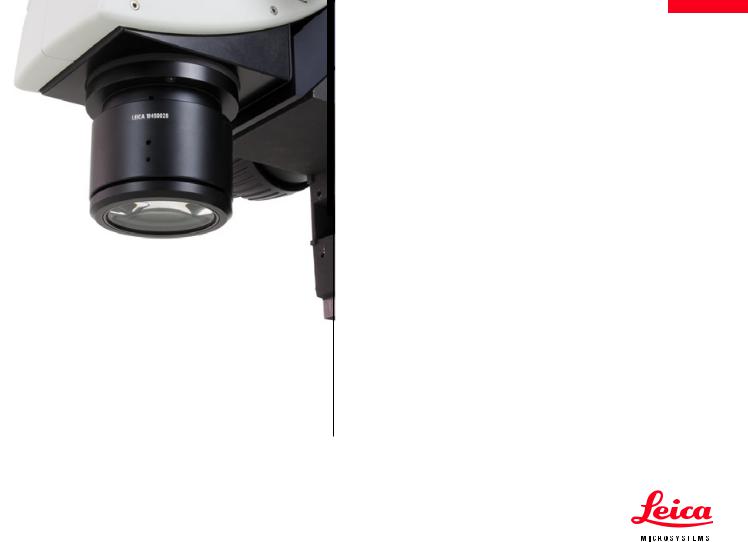
Leica M125
Leica M165 C
Leica M205 C
Leica M205 A
Manual

General Instructions
Safety concept
Before using your microscope for the first time, please read the "Safety concept" brochure included with your instrument. It contains additional information about handling and care.
Use in clean rooms
The Leica M series can be used in clean rooms without any problems.
Cleaning
Do not use any unsuitable cleaning agents, chemicals or techniques for cleaning.
Never use chemicals to clean colored surfaces or accessories with rubberized parts. This could damage the surfaces, and specimens could be contaminated by abraded particles.
In most cases, we can provide special solutions on request. Some products can be modified, and we can offer other accessories for use in clean rooms.
Servicing
Repairs may only be carried out by Leica Microsystems-trained service technicians. Only original Leica Microsystems spare parts may be used.
Responsibilities of person in charge of instrument
Ensure that the Leica stereomicroscope is operated, maintained and repaired by authorized and trained personnel only.
Leica M series |
Manual |
2 |
|
|
|

Safety concept
The individual modules of the Leica M stereomicroscopy series include an interactive CD-ROM with all relevant user manuals in 20 other languages. Keep it in a safe place, and readily accessible to the user. User manuals and updates are also available for you to download and print from our web site at www.stereomicroscopy.com.
This operating manual describes the special functions of the individual modules of the Leica M stereomicroscopy series and contains important instructions for their operational safety, maintenance, and accessories.
The "Safety concept" booklet contains additional safety information regarding the service work, requirements and the handling of stereomicroscope, accessories and electrical accessories as well as general safety instructions.
You can combine individual system articles with articles from external suppliers (e.g. cold light sources, etc.). Please read the user manual and the safety requirements of the supplier.
Before installing, operating or using the instruments, read the user manuals listed above. In particular, please observe all safety instructions.
To maintain the unit in its original condition and to ensure safe operation, the user must follow the instructions and warnings contained in these user manuals.
Leica M series |
Manual |
3 |
|
|
|

Symbols used
Warning of a danger
•This symbol indicates especially important information that must be read and
complied with. Failure to comply can cause the following:
Hazards to personnel
Functional disturbances or damaged instruments
Warning of hazardous electrical voltage
This symbol indicates especially important information that, if not observed,
can cause the following:
Hazards to personnel
Functional disturbances or damaged instruments.
Danger due to hot surface
This symbol warns against touching hot surfaces, e.g. those of light bulbs.
Important information
This symbol indicates additional information or explanations that intend to
provide clarity.
Action
This symbol refers to actions described in the text that are to be carried out.
Figures
(1)Numbers in brackets within the descriptions relate to the figures and the items within those figures.
Leica M series |
Manual |
4 |
|
|
|

Safety regulations
Description
The individual modules fulfill the highest requirements for observation and documentation of Leica stereo microscopes of the M series.
Designated use
See “Safety concept” booklet
Non-intended use
See “Safety concept” booklet
Never use M series microscopes or their components for surgical procedures (e.g. on the eye) unless they are specifically intended for that purpose.
The devices and accessories described in this operating manual have been tested for safety and potential hazards. The responsible Leica affiliate must be consulted whenever the device is altered, modified or used in conjunction with
non-Leica components that are outside of the scope of this manual.
Unauthorized alterations to the instrument or noncompliant use shall void all rights to any warranty claims!
Location of use
See “Safety concept” booklet
Set up the electrical components at least 10 cm from walls and combustible objects.
Avoid large temperature fluctuations, direct sunlight and vibrations. These conditions can distort measurements and micrographic images.
In warm and warm-damp climatic zones, the individual components require special care in order to prevent the build up of fungus.
Requirements for the owner/operator
See “Safety concept” booklet
Ensure that:
The M series stereomicroscopes and accessories are operated, maintained and repaired by authorized and trained personnel only.
All operators have read, understood and observe this user manual, and particularly the safety instructions.
Leica M series |
Manual |
5 |
|
|
|

Safety regulations (continued)
Repair, service work |
Installation in third-party products |
Health risks |
|
|
See “Safety concept” booklet |
See “Safety concept” booklet |
Workplaces equipped with stereomicroscopes |
|
|
|
facilitate and improve the viewing task, but |
Only original Leica Microsystems spare |
|
they also impose high demands on the eyes |
|
|
parts may be used. |
Disposal |
and holding muscles of the user. Depending on |
|
|
See “Safety concept” booklet |
the duration of uninterrupted work, asthenopia |
Before opening the instruments, switch off |
|
and musculoskeletal problems may occur. For |
|
|
the power and unplug the power cable. |
|
this reason, appropriate measures for reduction |
|
|
Legal regulations |
of the workload must be taken: |
Touching the live circuit can cause injury. |
See “Safety concept” booklet |
|
|
|
|
|
Optimal arrangement of workplace, work |
|
|
|
assignments and work flow (changing tasks |
Transport |
EC Declaration of Conformity |
frequently). |
|
|
Use the original packaging for shipping or |
See “Safety concept” booklet |
|
|
transporting the individual modules of the |
|
Thorough training of the personnel, giving |
|
Leica M stereomicroscopy series and the |
|
consideration to ergonomic and organiza- |
|
accessory components. |
|
tional aspects. |
In order to prevent damage from vibrations, |
|
The ergonomic design and construction of the |
|
|
disassemble all moving parts that (accord- |
|
Leica M stereomicroscopy series are intended to |
|
ing to the user manual) can be assembled |
|
reduce the exertion of the user to a minimum. |
|
and disassembled by the customer and |
|
|
|
pack them separately. |
|
|
Leica M series |
Manual |
6 |
|
|
|

Safety regulations (continued)
Direct contact with eyepieces can be a potential transmission path for bacterial and viral infections of the eye.
The risk can be kept to a minimum by using personal eyepieces for each individual or detachable eyecups.
Light sources: safety instructions |
Warning |
|
Protective measures of the manufacturer: |
UV radiation could damage the eyes. Therefore: |
|
|
UV protection screen in front of the speci- |
Never look into the light spot on the speci- |
|
men plane prevents the user from looking |
men plane without a UV protection screen. |
|
directly into the UV rays. |
|
|
|
Never look into the eyepieces if no excita- |
|
Dummy filter carriers in the free positions |
tion filter is in the beam path. |
|
of the rapid filter changer prevent direct UV |
|
|
radiation from reaching the eyes. |
Fill empty filter positions with dummy filter |
|
|
carriers (e.g. M165FC). |
|
UV filters are installed in the observation |
|
|
beam paths to protect the eyes. |
Do not select a white, strongly reflective |
|
|
background for the stage. |
The stray-light protection on the lamp |
|
|
|
housing prevents irradiation of the hands. |
|
Leica M series |
Manual |
7 |
|
|
|

Safety regulations (continued)
Supply unit
Always unplug the supply unit from the power supply:
When installing and disassembling the lamp housing
Before opening the lamp housing
When replacing the high-pressure mercury lamp and other parts, such as the heat-ab- sorbing filter or the collector
during maintenance work on the supply unit.
Lamp housing
Never open the lamp housing while the lamp is switched on. Risk of explosion, UV exposure, blinding!
Before opening the lamp housing, allow it to cool off for at least 15 minutes. Danger of explosion!
Never cover the air duct on the lamp housing. Danger of fire!
Mercury lamp
Follow the user manual and safety instructions provided by the lamp manufacturer, and, in particular, the section on how to proceed if a lamp breaks and releases mercury.
For transport, remove the mercury lamp, transport it in its original packaging and protect moving parts in the lamp housing using the transport anchors.
To minimize the risk of explosion, replace a discoloured mercury lamp promptly when it has reached the end of its rated life (follow the manufacturer's specifications and the minute meter on the supply unit).
Leica Microsystems assumes no liability for damage caused by exploding, incorrectly installed or improperly used mercury lamps.
Leica M series |
Manual |
8 |
|
|
|

Table of Contents
General Instructions |
2 |
Safety concept |
3 |
Symbols used |
4 |
Safety regulations |
5 |
|
|
The Leica M Series |
|
Congratulations! |
13 |
A Step Towards Infinity |
14 |
The Electronics: Comfort, Convenience and Safety |
15 |
The Modular Design: Everything is Relative |
16 |
Maximum Compatibility |
17 |
On We Go |
18 |
|
|
Assembly |
|
Base and Focusing Column |
20 |
Optics carrier |
21 |
Tube |
22 |
Eyepieces |
23 |
Objective |
24 |
Objective Nosepiece – Assembly |
25 |
Objective Nosepiece – Adjusting Parfocality |
26 |
AX Carrier – Preparation |
27 |
AX Carrier – Assembly |
28 |
Transmitted-light Base TL ST |
29 |
Transmitted-light Base TL BFDF: Before First Use |
30 |
Transmitted-light Base TL BFDF |
31 |
TL RC™ / TL RCI™ |
32 |
IsoPro™ Manual Cross-stage: Assembly |
33 |
IsoPro™ Motorized Cross-stage: Assembly |
36 |
Cables: Terminals |
40 |
Cables: Cable Duct |
41 |
Cables: Diagram |
42 |
Leica LED5000 MCI™ |
43 |
Leica LED5000 MCI™: Alternative Assembly |
44 |
Leica LED5000 RL |
45 |
|
|
|
|
Quick Start Guide |
|
The Fastest Route to Success |
47 |
Overview of an M series Microscope |
48 |
The Correct Interpupillary Distance |
49 |
Using the Eyepieces |
50 |
Focusing |
51 |
Adjusting the resistance of the focus drive |
52 |
Changing the magnification (zoom) |
53 |
Ratchet Steps and Magnification Levels |
54 |
Parfocality: More Comfort and Convenience for Your Work |
55 |
Iris Diaphragm |
56 |
Leica M series |
Manual |
9 |
|
|
|
Eyepieces |
|
Magnification Factors of the Eyepieces |
58 |
Health Notes |
59 |
Dioptric correction |
60 |
Dioptric Correction and Parfocality |
61 |
Graticules |
62 |
|
|
Photography & Video |
|
Photography & Video |
64 |
Photo tubes and C-mounts |
65 |
Trinocular video/phototube 50% |
66 |
Trinocular video/phototube 100% |
67 |
|
|
Microscope Carrier |
|
The Microscope Carrier AX |
69 |
The Objective Nosepiece |
71 |
|
|
Objectives andoptical accessories |
|
The Different Types of Objectives |
73 |
|
|
|
|
Bases |
|
Transmitted-light Base TL ST: Controls |
75 |
Transmitted-light Base TL ST: Operation |
76 |
Transmitted-light Base TL ST: Lamp Replacement |
77 |
Transmitted-light Base TL BFDF: Controls |
78 |
Transmitted-light Base TL BFDF: Operation |
79 |
TL RC™ / TL RCI™: Controls |
80 |
TL RCI™: The Deflection Mirror |
81 |
TL RCI™: Color Intensity and Temperature |
82 |
TL RC™ / TL RCI™: Operation |
83 |
TL RCI™: Methods in Transmitted Light |
84 |
TL RCI™: Relief Images |
85 |
Using Filters |
87 |
IsoPro™ (Non-motorized): Controls |
88 |
IsoPro™ (Motorized): Controls |
89 |
|
|
System Illumination |
|
Leica LED5000 MCI™ |
91 |
Leica LED5000 RL |
93 |
Leica M series |
Manual |
10 |
|
|
|
|
|
|
|
|
|
|
|
Accessories |
|
|
|
Leica PSC Controller |
95 |
|
|
|
|
|
|
Dimensional Drawings |
|
|
|
Leica M125 / M165 C |
97 |
|
|
Leica M205 C |
101 |
|
|
Leica LED5000 MCI |
104 |
|
|
Leica LED5000 RL |
105 |
|
|
|
|
|
|
Specifications for the Bases |
|
|
|
Transmitted-light Base TL ST |
107 |
|
|
Transmitted-light Base TL BFDF |
108 |
|
|
TL RC™ / TL RCI™ |
109 |
|
|
IsoPro™ Motorized XY Stage |
110 |
|
|
|
|
|
|
Appendix |
|
|
|
Calculating the Total Magnification and Field of View Diameter |
112 |
|
|
Care, Maintenance, Contact Persons |
113 |
|
|
Leica M series |
Manual |
11 |
|
|
|
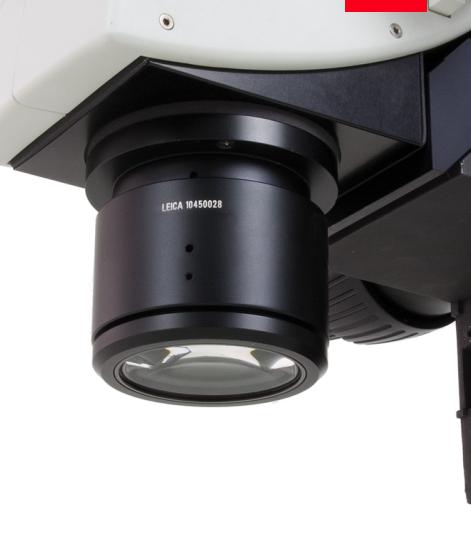
The Leica M Series
Leica M series |
Manual |
12 |
|
|
|

Congratulations!
Congratulations on obtaining your new Leica M series stereomicroscope. We are convinced it will exceed your expectations, as never before have we applied our decades of experience in the areas of optics, mechanical engineering and ergonomics in such an uncompromising manner.
The M series embodies all the qualities you associate with the name Leica Microsystems: excellent objectives, high-quality engineering, and reliability. Furthermore, the modular design ensures that the M series adapts perfectly to your needs—no matter which accessories you require for your tasks.
Though the reliability and robustness of Leica stereomicroscopes is legendary, like any high-tech product, the M series requires a certain degree of care and attention. Therefore, we recommend that you read this manual. It contains all the information you need regarding operation, safety and maintenance. Simply observing a few guidelines will ensure that even after years of intensive use, your stereomicroscope will continue to work as smoothly and reliably as on the very first day.
We wish you the best of success in your work—after all, you are now equipped with the best tool!
Leica M series |
Manual |
13 |
|
|
|

A Step Towards Infinity
Ever since their introduction by Horatio S. Greenough, stereomicroscopes have worked according to the optical principles based primarily on Ernst Abbe's research. For over a century, ingenious optics designers and engineers have worked to push magnification, resolution and image fidelity to the limit permitted by optics.
In doing so, they have always been constrained by the interrelation between three factors: the higher a microscope's resolution, the lower the available working distance. If one increases the distance of the optical axes, the three-dimen- sional image seen by the observer becomes distorted—a sphere becomes an ellipse, a flat surface curves toward the observer.
Limits are made to be broken.
The Leica M205 C is the world's first stereomicroscope with a zoom range of 20.5:1. This accomplishment, however, was not enough for Leica's engineers. With the new FusionOptic™ in the M205 C, they have succeeded in going yet another step beyond previous limits. In addition to the increase in magnification, the resolution, too, has been increased to up to 1050 lp / mm*, which corresponds to a resolved structure size of 472 nm.
Of course, this performance increase benefits your everyday work. Set up your specimens on the microscope with comfortable freedom of movement and discover details in stereomicroscopy that you could never see before.
* Leica M205 C with 1.0× planapochromat and 10× eyepieces
Leica M series |
Manual |
14 |
|
|
|
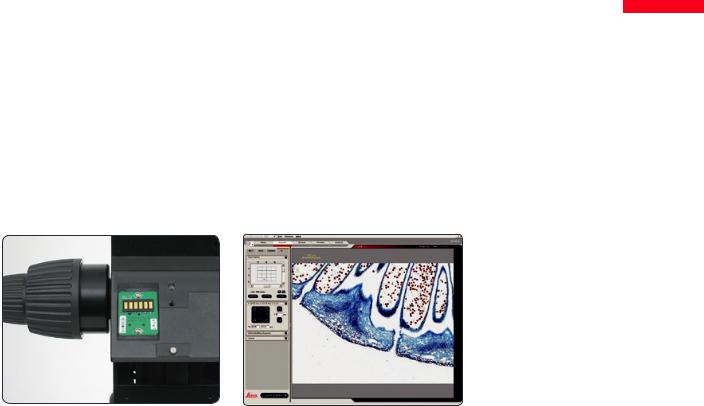
The Electronics: Comfort, Convenience and Safety for your Experiments
Never before have electronics been used as extensively in a Leica series as in the new M series. Optics carrier, tripod, base and illuminator are all connected using electrical contacts—which provides a number of advantages.
Reliability for your experiments
Exact reproducibility of results is an increasingly common demand, particularly in research and development. The continuous encoding captures parameters such as the magnification, the illumination, the position of the iris
diaphragm and more to the Leica LAS software. Thus you always know the conditions under which an image was acquired.
Fewer cables
A large part of the cables have been routed in the interior of the column. Data are also transferred via the interface between the column, the optics carrier and the carrier. The direct result is that you need fewer cables—this not only makes your workstation neater and more comfortable, it even makes it appear larger.
Contacts not only transmit data, but also supply the power.
Leica Application Suite (LAS) evaluates the transmitted data and can restore the test situation later.
Leica M series |
Manual |
15 |
|
|
|

The Modular Design: Everything is Relative
The Leica M series provides maximum flexibility in choosing equipment, thanks primarily to the modular configuration and the compatibility that Leica has painstakingly maintained for decades. The optics carriers, eyepieces, bases and more can be combined in any way you choose, allowing you to create the microscope that best suits your needs.
Despite this, you will notice that the controls and individual components do not differ significantly. Whichever configuration you choose, you will quickly feel right at home.
Have a special request? Let us know!
Leica Microsystems enjoys an exceptional reputation when it comes to devising customerspecific solutions. If you have a special request that cannot be met with standard parts, contact your Leica consultant. We have a solution for every problem.
Leica M series |
Manual |
16 |
|
|
|

Maximum Compatibility
Leica engineers were careful to ensure that the new M series—like its predecessors—remains compatible with existing series. This means that objectives, bases, tubes and so on can be reused.
Objectives
All new objectives of the M series are parfocal, meaning that when used with the objective nosepiece, they can be replaced while keeping the specimen in perfect focus.
If you prefer, you can continue to use the previous objective series. In this case, parfocality is no longer guaranteed.
Tubes
The interface between the optics carrier and the tube has remained the same, so existing tubes fit the new M series. The new tubes are designed for eyepieces with field number 23, while the predecessor models were only designed for field number 21, resulting in a smaller object field.
Eyepieces
However, the new M-series eyepieces models have an audible and tangible click to provide immediate feedback in case of accidental adjustment.
Leica M series |
Manual |
17 |
|
|
|
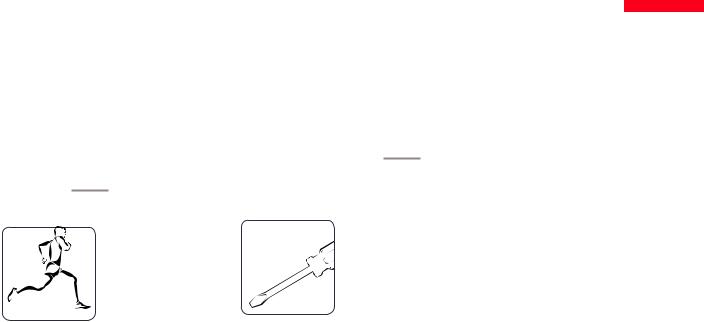
On We Go
If your new Leica microscope has already been assembled and commissioned by your Leica consultant, click here to skip through the installation instructions and go directly to the Quick Start Guide on page 46.
If, on the other hand, you are assembling the microscope yourself, continue with the "Assembly" chapter, which begins on page 19.
Leica M series |
Manual |
18 |
|
|
|
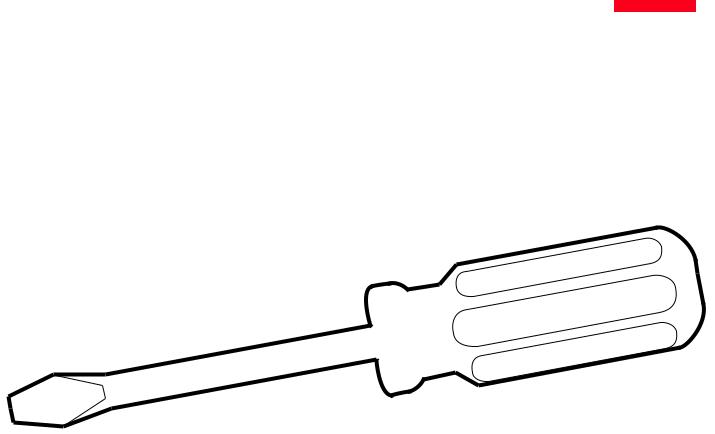
Assembly
Leica M series |
Manual |
19 |
|
|
|
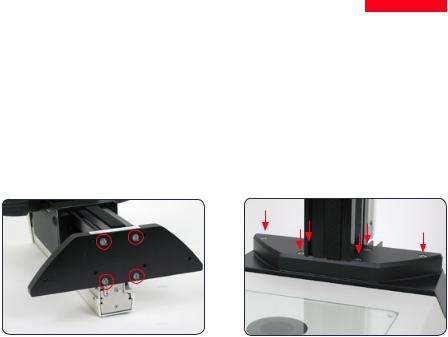
Base and Focusing Column
The first step is to connect the focusing column |
Assembling the column adapter |
Assembling the focusing drive |
of the M series to the corresponding base. |
1. Securely install the column adapter on the |
2. Securely screw the focusing column to the |
|
column using the four included screws. |
base using the six included screws. |
Tools used |
|
|
Hex socket screwdriver, 3 mm |
|
|
Leica M series |
Manual |
20 |
|
|
|

Optics carrier
Tools used |
Assembling the optics carrier |
Hex socket screwdriver, 4 mm |
1. Place the optics carrier on the focusing |
|
column so that the screw fit into the thread |
|
provided and the lug fits into the groove. |
2.Press the optics carrier backwards to the focusing column and screw it in place using your other hand.
Leica M series |
Manual |
21 |
|
|
|
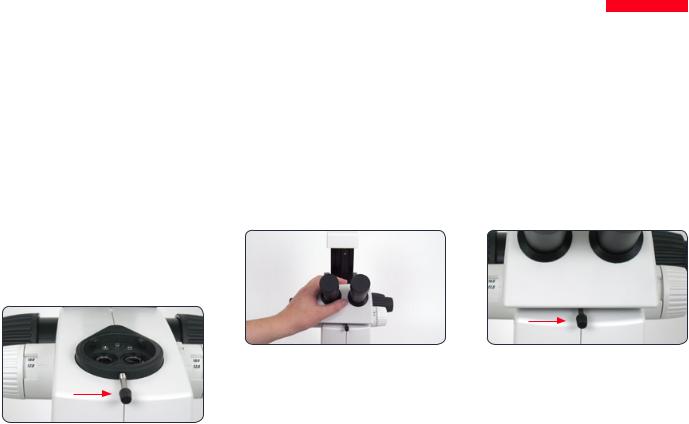
Tube
All intermediate tubes that fit between the optics carrier and the binocular tube are fitted in the same manner.
Tools used
No tools required.
Preparations
1.Unscrew the positioning screw and remove the protective cover.
Assembling the tube
2.Push the tube (for example, the inclined binocular tube) into the dovetail ring and rotate it slightly in both directions until the positioning screw meshes with the guide groove.
3. While holding the tube only slightly, carefully tighten the positioning screw. It is automatically brought to the correct position.
Leica M series |
Manual |
22 |
|
|
|
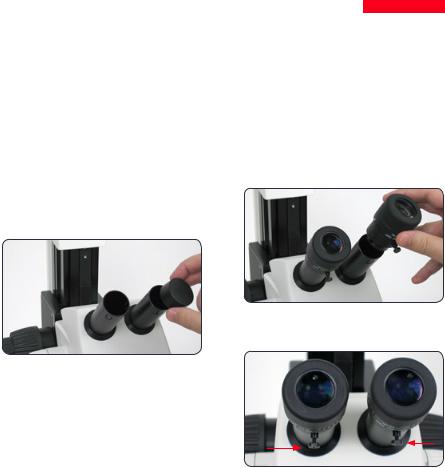
Eyepieces
Tools used |
Preparation |
Inserting the eyepieces |
|||
No tools required. |
1. |
If you want to use an optional graticule, |
3. Push the eyepieces into the tubes as far as |
||
|
|
insert it now (page 62). |
they will go and check to ensure that they |
||
Magnification range |
|
|
|
|
fit tightly and accurately. |
You can extend the overall magnification range |
2. |
Remove the plastic tube guard. |
|
||
using available 10×, 16×, 25× and 40× wide- |
|
|
|
|
|
field eyepieces for persons wearing glasses. |
|
|
|
|
|
4. Securely tighten the clamping screws.
Leica M series |
Manual |
23 |
|
|
|

Objective
Tools used |
Attaching the objective |
Alternative fastening options |
||||
No tools required. |
Hold the objective firmly during assem- |
If using the objective nosepiece, read the |
||||
|
• bly and disassembly so that it does not |
instructions on page 25. |
||||
|
fall onto the stage plate. This applies particu- |
|
|
|
|
|
Preparation |
larly to the 2× planapochromatic objective, |
If using the AX carrier, read the instructions |
||||
1. Remove the protective cap on the optics |
which is very heavy. Remove all specimens from |
on page 27. |
||||
carrier by turning it. |
the stage plate first. |
|
|
|
|
|
|
2. Screw the objective clockwise into the |
|
|
|
|
|
|
optics carrier. |
|
|
|
|
|
Leica M series |
Manual |
24 |
|
|
|

Objective Nosepiece – Assembly
Preparations
• Hold the objectives firmly during assembly and disassembly so that they
do not fall onto the stage plate.
Move the drive housing all the way upwards and remove the optics carrier, if the carrier has already been installed.
Assembly
1.Remove the transport anchor from the objective nosepiece.
2.Rotate the moving part by 90° and attach the objective nosepiece to the drive housing from the front (!). Screw the objective nosepiece firmly into place.
3.Unscrew the three Phillips screws on the objective mount of the optics carrier and remove the intermediate ring.
4.Screw the optics carrier onto the objective nosepiece.
5.Screw both objectives onto the objective nosepiece. It makes no difference which position an objective occupies.
6.Unscrew the locking screws on both sides of the objective nosepiece.
You can now adjust the parfocality (see instructions on the next page).
Leica M series |
Manual |
25 |
|
|
|
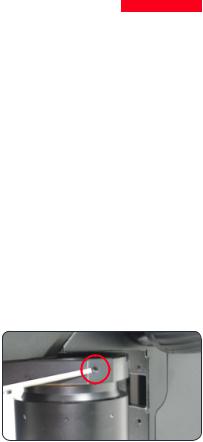
Objective Nosepiece – Adjusting Parfocality
The following procedure only has to be carried out once. Afterwards, both objectives are parfocal, meaning that the specimen remains in focus when the objective nosepiece is rotated.
This procedure must be repeated if you replace either of the two objectives with another.
The following example assumes the combination of the 1× and 2× planapochromats. If you are using another objective combination, replace the 2× objective in the description with the objective with the stronger magnification.
Preparation
Open the iris diaphragm.
Set the dioptric correction of the eyepieces to "0".
Adjustment
1.Rotate the 2× objective into the beam path and set it to the lowest magnification.
2.Focus on the specimen.
3.Rotate the 1× objective into the beam path.
4.Turn the objective on the thread in both directions until the specimen appears sharp.
5.Toggle to the 2× objective.
6.Select the strongest magnification and refocus until the specimen appears absolutely sharp.
7.Toggle to the 1× objective.
8.Turn the objective on the thread in both directions until the specimen appears absolutely sharp.
By means of zooming, check that the behavior of the objective is parfocal. Repeat the check with the other objective. If it is not parfocal, repeat the procedure.
9. Tighten the locking screws.
Leica M series |
Manual |
26 |
|
|
|
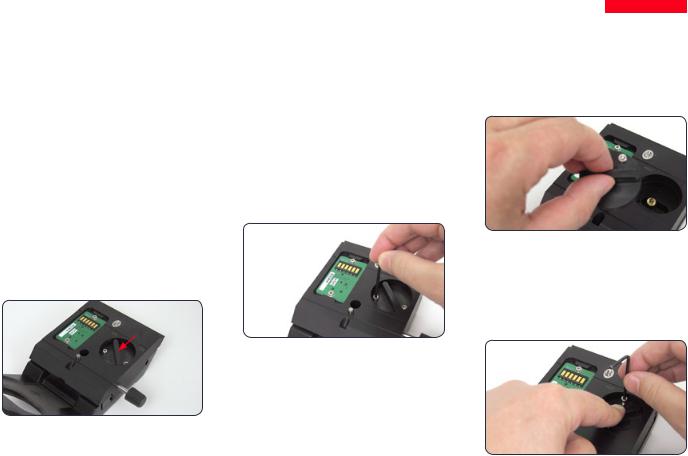
AX Carrier – Preparation
Tools
Hex socket screwdriver, 2.5 mm
Preparing the AX carrier
Before the AX carrier is installed, it may first have to be prepared for the optics carrier to be used (Leica M125, M205 C or M165 C).
1. Check the switch position.
If the switch position corresponds to the optics carrier used, skip the following steps. Otherwise, proceed as follows:
2.Unscrew the two screws that hold the switch in position.
3.Pull out the switch, rotate it into the desired position and reinsert it.
4.Important: push the switch all the way into the mount while reinserting the screws. Only this ensures that the switch is positioned correctly.
Leica M series |
Manual |
27 |
|
|
|

AX Carrier – Assembly
Tools
Hex socket screwdriver, 4 mmPhilips screwdriver
Once the AX carrier has prepared for the corresponding optics carrier, it can be installed.
1.Move the slide of the AX carrier into mid position.
2.Install the AX carrier on the focusing column.
3. Screw the objective to the AX carrier.
4.Unscrew the three holding screws and remove the adapter ring on the optics carrier.
5. Install the optics carrier on the AX carrier.
Wrong |
Right |
Leica M series |
Manual |
28 |
|
|
|
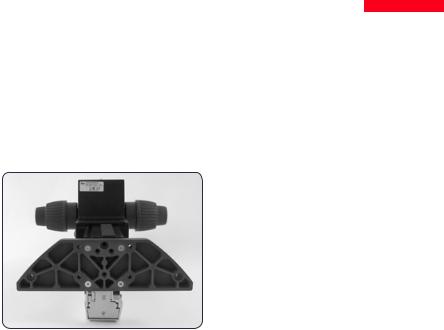
Transmitted-light Base TL ST
Unpacking the base |
Focusing drive and column |
2. |
Attach your focusing drive column to the |
The base is delivered with the adapter plate |
1. Unscrew the extension plate from the base |
|
bottom using the 4 Allen screws. |
installed. Make sure the devices are unpacked |
using the Allen key provided. |
|
|
on a flat, sufficiently dimensioned, and non-slip |
|
3. |
Reattach the adapter plate to its original |
surface. |
|
|
position using the 6 Allen screws. |
Leica M series |
Manual |
29 |
|
|
|
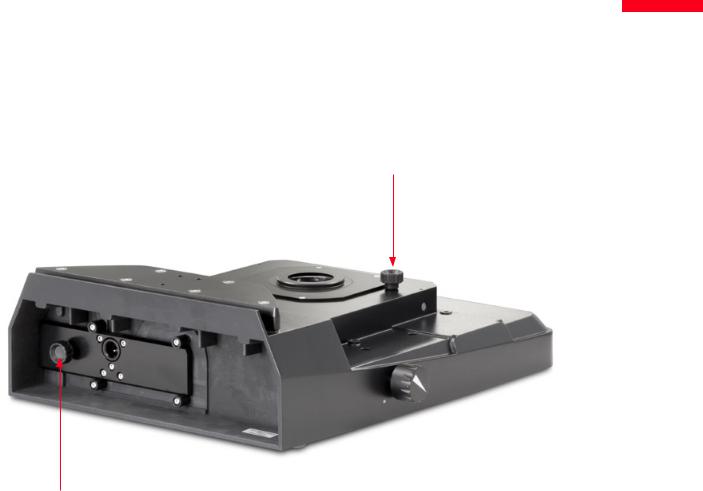
Transmitted-light Base TL BFDF: Before First Use
Removing the transport anchors |
|
|
Before you can use the transmitted- |
|
|
• light base for the first time, it is abso- |
|
|
lutely necessary to remove the two transport |
Anchor of mirror |
|
anchors as follows. |
||
|
Anchor of switching slide
Leica M series |
Manual |
30 |
|
|
|
